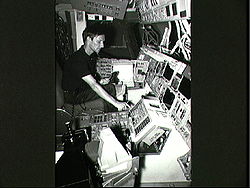
Shuttle Avionics Integration Laboratory
Encyclopedia

Lyndon B. Johnson Space Center
The Lyndon B. Johnson Space Center is the National Aeronautics and Space Administration's center for human spaceflight training, research and flight control. The center consists of a complex of 100 buildings constructed on 1,620 acres in Houston, Texas, USA...
in Houston, Texas
Houston, Texas
Houston is the fourth-largest city in the United States, and the largest city in the state of Texas. According to the 2010 U.S. Census, the city had a population of 2.1 million people within an area of . Houston is the seat of Harris County and the economic center of , which is the ...
.
It was the only facility in the Space Shuttle Program where actual orbiter hardware and flight software can be integrated and tested in a simulated flight environment. It supported the entire Space Shuttle
Space Shuttle
The Space Shuttle was a manned orbital rocket and spacecraft system operated by NASA on 135 missions from 1981 to 2011. The system combined rocket launch, orbital spacecraft, and re-entry spaceplane with modular add-ons...
program to perform integrated verification tests.
The testing process is extensive and rigorous; the software on the Shuttle is often considered to be among the most bug-free of operational systems.
The laboratory contains a complete avionics mock-up of a Shuttle, designated
Orbiter Vehicle Designation
Each NASA space shuttle designation is composed of a prefix and suffix separated by a dash. The prefix for operational shuttles is OV, for Orbiter Vehicle.The suffix is composed of two parts: the series and the vehicle number.Series:...
OV-095. Whilst only a skeleton of an orbiter, the electronics are identical in position and type to those used on the Shuttle; it is a sufficiently faithful replica that crews sometimes prefer to use it to train on, rather than the training simulators.
NASA personnel who have been assigned to SAIL testing include Charlie Bolden (current NASA Administrator), Michael Coats
Michael Coats
Michael Lloyd Coats is an engineer and former NASA astronaut, raised in Riverside, California...
(Current Director at JSC NASA), Brewster Shaw (Boeing Vice President of Space Exploration Division) and Al Crews
Albert H. Crews
Albert Hanlin Crews, Jr. is a retired colonel in the United States Air Force and a former USAF astronaut. He was born on in El Dorado, Arkansas and is married with three children....
(selected as an astronaut for the X-20 Dyna-Soar
X-20 Dyna-Soar
The X-20 Dyna-Soar was a United States Air Force program to develop a spaceplane that could be used for a variety of military missions, including reconnaissance, bombing, space rescue, satellite maintenance, and sabotage of enemy satellites...
).
The FIRST SAIL CDR (Commander - left seat) was James E. Westom/Rockwell International, retired Major USAF. His service as SAIL CDR started in the Approach and Landing test phase, where the orbiter (flying part) was launched off the top of the NASA C-747 vehicle to prove it could fly on its own in the atmosphere. Maj Westom's duties were from 1974-1989, when he had to retire early for family medical support.

